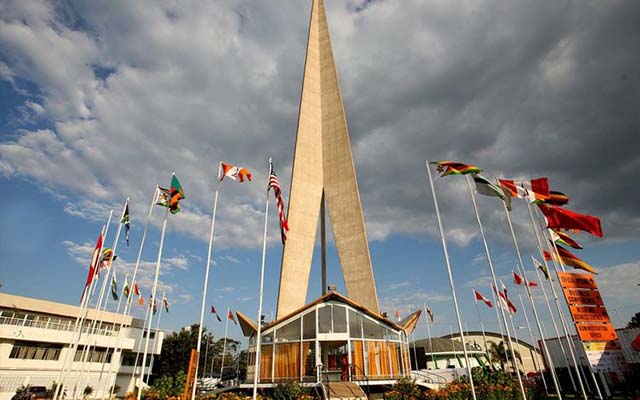Environmental stories that shaped our discourses in 2017

Even though EMA had good reason to outlaw kaylites – the packaging material has emerged to become one of the greatest, complex environmental concerns in cities and towns today
Jeffrey Gogo Climate Story
As is custom, at the end of each year we look back to reflect on the events of the year gone past. In 2017, the year in climate change and the environment started off forcefully, with double tropical cyclones causing massive flooding, ending with some drama in politics that saw the Ministry of Environment, Water and Climate split and patched back together again as quickly as it had been divided.
From floods to heat waves, portfolio splits to product bans, earthquakes to pest attacks to the Donald Trump “comical show”, the year in review was both a story of devastation and hope, and here is a selection of the stories that stuck with us in 2017.
Too much rain invites disaster and pests
Weeks of torrential rain pounded much of Zimbabwe early in the year, causing rivers, including Save, the country’s biggest, to overflow, with dozens of dam walls breached, and thousands of acres of crop land swamped.
By the first week of February, more than 100 people had died, over 1 000 homes destroyed and 40 schools damaged while entire villages in the low veld had been completely cut off as bridges collapsed.
The Public Works Ministry estimated the cost of the damage to public infrastructure at above $500 million countrywide. Coming hard on the heels of a devastating El Nino-induced drought in the 2015/16 farming season, this year’s excess of rain was both a blessing and a curse: blessing in the sense that it ended years of hunger, with over 2 million tonnes of the maize staple harvested.
A curse becase people died and property damaged. And also because too much rain brought in attacks by pests – the fall armyworm – causing 130 000 hectares of crop damage across Zimbabwe alone, and in several southern African countries. The worm – quick on flight, not easily detectable and difficult to control — is expected to remain a headache in the current cropping season, as scientists try to wrap their heads around the American invader.
Product bans, the Kaylite uproar
Two important product bans were effected separately by energy regulator ZERA and environment regulator EMA, during the course of 2017: the one on energy inefficient light bulbs, and the other on polystrene-based packaging material, popularly known as kaylite.
As a means of enforcing compliance, bans are some of the most effective weapons available to authorities, moreso in an economy where matters concerning the natural environment are almost always relegated to the backwaters of business and individual decisions.
It is crucial that when the bans are applied, regulators do so in a transparent and inclusive way to avoid instances of disorder, loss and revulsion by businesses and individuals towards the implementing authority. With the kaylite ban of July 13, the Environmental Management Agency achieved the opposite.
Even though EMA had good reason to outlaw kaylites – the packaging material has emerged to become one of the greatest, complex environmental concerns in cities and towns today – the regulator got flak from supermarket owners, restaurant owners and fast food shop owners, the biggest consumers of kaylite, for the seeming impromptu ban, that lacked consultation.
The bottomline – people love kaylite, nature doesn’t.
And on May 1 the Zimbabwe Energy Regulatory Authority outlawed the use of Thomas Edison’s incandescent bulb, along with the rest of its power-guzzling cousins such as fluorescent tubes, as the regulator sought to pivot the economy away from energy inefficient lighting systems at a time climate change is escalating. The law prevents high energy consuming products from being sold, made or imported into Zimbabwe, ZERA said, hoping that would save up to 40 megawatts of electricity per year.
The measures dovetail with Zimbabwe’s broader plans under the Paris Agreement, to cut greenhouse emissions by 33 percent by 2030 through improved energy efficiency and increased investment into renewables.
Paris Agreement ratification, Trump circus
On September 6 Zimbabwe ratified the Paris Treaty on climate change of 2015, hardly two months after US president Donald Trump made good on his election promise of pulling the world’s second largest polluter out of the accord citing “national interests.”
The ratification means that Zimbabwe is now legally obliged to stick to the terms of the accord, terms that include a commitment to cutting the emission of climate warming gases like carbon dioxide and methane. This will also open access to the Treaty’s several funding mechanisms, necessary to help people and the economy cope with climate change.
And as the country put pen to paper, volatile Trump was busy accusing the Paris Agreement of short-changing America’s interests, that he plans to build on coal and oil – the world’s biggest emitting industries.
His actions earned the US deserved worldwide scorn, as well potential isolation on other global geo-political matters.
Heatwave, earthquake, splits
The night of April 3, a cool and calm night, the Meteorological Services Department 9pm TV weather forecast said nothing about the earth tremors that had shaken large parts of Zimbabwe barely an hour earlier, stoking apocalyptic fear among thousands of people. But a 6.5 magnitude Botswana-epicentred quake had indeed hit the country, and science didn’t see it coming.
Scientists still cannot predict quakes, a sudden and violent shaking of the ground caused by waves passing through it. They have a pretty good idea of where an earthquake is most likely to hit, but they still can’t tell exactly when it will happen.
That’s just one problem. The biggest is what the Botswana quake brought to the fore – emerging geological anomalies in places that hitherto have been considered safe zones, such like Zimbabwe and much of southern Africa. Just how safe are we from earthquakes? Your guess is as good as mine.
Then in October another wave of heat hit, temperatures smashing records in areas like Kariba, Nyanga, the Victoria Falls, Chiredzi and Beitbridge, causing a range of health and environmental implications. Kariba tipped the thermometer at 45 degrees Celsius.
The successive year after year extreme events, all linked to climate change, from too much heat to drought, excessive cold to flooding indicate some of the most pressing issues in post-independent Zimbabwe.
Politics took sway in November. Former president Robert Mugabe rearranged the Ministry of Environment, Water and Climate. He removed the environment portfolio from the Ministry, adding it to that of Tourism, in a thought-out power play meant to weaken Oppah Muchinguri-Kashiri ministerial responsibilities.
Without the environment file, Mrs Muchinguri-Kashiri had effectively lost control over important state agencies like the Forestry Commission, Parks and Wildlife, and the Environmental Management Agency, key to meeting national climate goals.
However, no sooner had former President Mugabe been ousted from power, the new President Emmerson Mnangagwa rejoined the Environment portfolio to that of Water and Climate, under Mrs Muchinguri-Kashiri, to the former head’s spite. In 2018, we will be looking out on how the Environment Minister implements measures to deliver clean water, cleaner energy, tame poaching and more importantly, end water pollution from mining activities. The list is very long.
God is faithful.









Comments